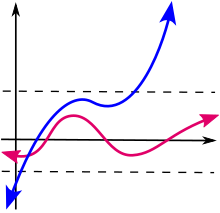
Back دالة محدودة Arabic Funció fitada Catalan Omezená funkce Czech Beschränkte Abbildung German Barita funkcio Esperanto Fonction bornée French Función limitada Galician פונקציה חסומה HE Takmarkað fall Icelandic Funzione limitata Italian
This article needs additional citations for verification. (September 2021) |

In mathematics, a function defined on some set with real or complex values is called bounded if the set of its values is bounded. In other words, there exists a real number such that
for all in .[1] A function that is not bounded is said to be unbounded.[citation needed]
If is real-valued and for all in , then the function is said to be bounded (from) above by . If for all in , then the function is said to be bounded (from) below by . A real-valued function is bounded if and only if it is bounded from above and below.[1][additional citation(s) needed]
An important special case is a bounded sequence, where is taken to be the set of natural numbers. Thus a sequence is bounded if there exists a real number such that
for every natural number . The set of all bounded sequences forms the sequence space .[citation needed]
The definition of boundedness can be generalized to functions taking values in a more general space by requiring that the image is a bounded set in .[citation needed]
- ^ a b Jeffrey, Alan (1996-06-13). Mathematics for Engineers and Scientists, 5th Edition. CRC Press. ISBN 978-0-412-62150-5.
© MMXXIII Rich X Search. We shall prevail. All rights reserved. Rich X Search
















